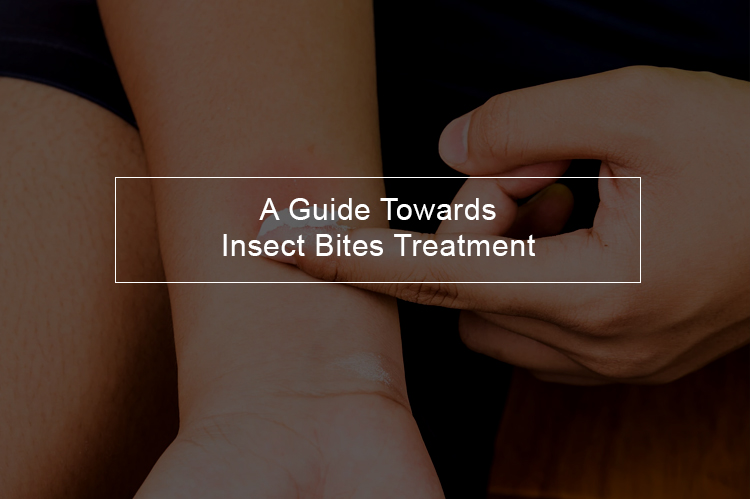
You can treat a majority of bug bites and stings by simply using a mild soap and clean lukewarm water to wash off the bite site then applying either a wrapped ice pack or a cold compress to minimize impacts of swelling. To prevent infection from entering your bite wound, avoid scratching or rubbing the bite site. Take OTC painkillers if the wound is either swollen or is causing you some pain. For more severe cases that trigger allergies, for instance, seek immediate medical assistance either through immunotherapy at an allergy medical center or visit a doctor for accurate medicine prescription. You may also use an OTC hydrocortisone cream while for mild bites such as a mosquito bite apply calamine lotion.
First Aid Remedies for Insect Bites
Home Treatments for Stings and Bites
If you or any person experiences extreme signs of insect bite allergies, make sure you seek instant medical care. You should also stick to the tips provided in this section of the guide to assist in first aid response. If there aren’t any signs of serious allergic responses then treat the affected area for mild symptoms:
Removing a sting or Venom sac Stuck on the Skin
If you’ve just been stung by a bee, chances are high it has left its venom sac plus the sting on your body and you need to remove it immediately.You can remove the sting by using your fingernails or use a credit card for the same task. Take care when you’re scraping out the sting not to further spread the venom to neighboring skin, also avoid puncturing the venom sac. Avoid using tweezers or pinching the sting on your skin since it only increases the risks of spreading the venom. In case the bee attacks an infant, the sting should be removed by an adult. Both hornets and wasps, however, don’t leave behind stings on your skin which means they can sting you several times. The best way to avoid a repeat attack from either of these two insects is to move away calmly from the area they sting you before.
Minimizing the Swelling Impacts of an Insect Bite
Next step is washing the bite area using mild soap and clean water. You should then apply an ice pack or a cold cloth soaked in cold water on the affected region for a 10 minute-interval to assist in minimizing inflammation effects as well as pain. Ensure you cover the ice with a clean towel before applying on your skin to protect your skin surface. Spread a mixture of water and baking soda or a calamine solution on the bite area a couple of times every day to assist in calming any itchiness or pain from the bite. Calamine lotion is effective because it is an antihistamine ointment that suppresses histamine which is responsible for the bite side effects.
Additional Treatment for a Swollen or Painful Bite
If the bite or sting is painful or swollen, you can also: Cover ice with a thin towel and apply it on the affected region. Swallow painkillers like ibuprofen or paracetamol, these medicines are recommended for anyone above the age of 16. Don’t administer aspirin to infants below this age limit. Creams and sprays containing mild hydrocortisone, antihistamine or local anesthesia are effective for preventing inflammation or itching. Swallow an OTC antihistamine pill to assist in minimizing any swelling
In case you experience a serious case of local swelling, a doctor will recommend a short prescription of prednisolone (an oral corticosteroid)y for about 3-5 days. If you develop an allergy following an insect sting or bite, for instance, a rash, the doctor will likely recommend an adrenaline auto-injector. You may also be referred to an allergy clinic for more checks and treatment.
How Can I Handle a Blister that Forms After an Insect Bite?
Blisters may appear on your skin following an insect bite or sting, what you should never do is burst them open to avoid infecting the wound. These blisters rarely cause pain when they develop, unless they burst and reveal the vulnerable skin below. The best way to handle this type of blister is to wrap it with adhesive plaster or bandage to safeguard the affected region.
Tips for Managing Infected Bug bites
Seek immediate medical care from a general practitioner in case the bite area turns soft, is filled with pus, your glands get swollen or you develop flu-like symptoms. The doctor will recommend oral antibiotics to manage any infections caused by germs. Commonly the medication lasts about a week with a prescription of 2-4 times per day.
Emergency treatment for a severe allergic reaction to Insect Bites
Proper Handling of Insect Bite Allergies
In case you notice symptoms of serious alley responses from the bite or sting:
- Immediately seek assistance from emergency services like dialing 911. You should probably call for help before administering further treatment, in case you’re on your own.
- Ensure there is an epinephrine auto-injector always close with you or the victim. Use this first aid medication as instructed on the label guide.
- Ensure you remain calm or urge the victim to stay cool then raise your legs after lying down. In case there is a nausea feeling or an urge to vomit, turn on your side to let the vomit exit without resistance in order to avoid choking.
- Immediately start CPR if someone stops breathing or falls out of consciousness. Keep administering the mouth to mouth until you can access proper medical assistance. At this stage keep away any type of food from the victim so as not to worsen the condition.
Ways to Get Rid of Mosquito Bites and Beat That Persistent Itch
5 DIY Remedies for an Irritating Mosquito Bite
This section of the guide offers an insight to quick treatment options to get rid of that annoying mosquito bite itch:
Applying Calamine lotion on an Itchy Mosquito Bite
Calamine lotion comprises of zinc oxide and comes in a bubblegum-type color, this ointment should be the first option when tacking mosquito bites that cause itchiness. This ointment will cool your skin which assists in alleviating any discomfort or itching. The effects of this lotion usually fade after a few hours, you can keep applying it on your skin till you stop itching. In case the calamine lotion isn’t enough to eliminate the itch, you can supplement it with creams such as antihistamine and hydrocortisone, available at local pharmacies as OTC medicine.
How to use Hydrocortisone cream For Mosquito Bites?
Applying an OTC hydrocortisone cream or ointment that has 1 percent hydrocortisone content may yield better results in case you used calamine lotion and you didn’t notice any change. This type of cream has a corticosteroid content that assists in minimizing swelling, redness, inflammation as well as relieving itchiness. Visit a doctor to get a stronger prescription if you are already using an over- the- counter cream with no change. Spread a thin layer of ointment on the affected region two times daily or as the doctor prescribes. Using excess hydrocortisone cream may result in skin pigmentation as well as increase irritation. Instead, you should apply calamine lotion if you’ve already applied hydrocortisone cream and the itch doesn’t fade.
Applying an Ice Pack on a Mosquito Bite
Putting a cold cloth or an ice pack on the bite will cause vasoconstriction which reduces the quantity of blood flow to the affected region thereby reducing itchiness and swelling. An ice pack is an excellent supplementary remedy that you can use in between intervals of applying a hydrocortisone cream for example. Take an ice pack and cover it with a thin towel than put it on the bite for about 10 minutes. Keep up this procedure for about an hour.
Aspirin Paste as an Effective Remedy for Mosquito Bites
Aspirin is a common medicine for headaches, as such you can also take aspirin tablets to relieve bug bite inflammation due to its anti-inflammatory feature. To achieve the best results, crush the tablet and add water to form a paste then apply it on the affected region.
Apply Mentholated creams on a Mosquito Bite
There are different forms of a mentholated cream, you can use a sore muscle spray or cream as long as it has a methanol content. This cream will bring about a cooling effect that will reduce the itch. A good hack is refrigerating the creams and sprays you use that contain methanol rather than purchasing new products. Follow the label instructions when applying the methanol cream, usually for small regions like a mosquito bite you’ll just need to tap the cream on the bite.ections.
Treatment for Mild and Severe Spider Bites
How Can I Handle Spider Bites?
You won't have to worry about most spider bites since they’re harmless. Usually, spider bite symptoms start to appear a few hours to a day after it’s bitten you. These bite symptoms resemble those from other common bugs, and they include
- Itchiness
- Reddish appearance
- Pain
- Inflammation
However you should be wary about other types of spiders like the brown recluse and black widow that usually deliver painful bites that may result in severe allergies.
First Aid Treatment of a Black Widow or Brown Recluse Spider Bite
These guidelines are useful if you’ve been bitten by other common harmless spiders:
- Rinse off the bite region using mild soap and clean water.
- Apply a wrapped up- ice pack or a cold cloth on the affected region for approximately 10 minutes to counteract swelling and pain that may occur.
- Spread a baking soda paste or calamine lotion on the bite to alleviate itchiness and pain.
Emergency treatment for a brown recluse or black widow spider bite
Individuals who have been bitten by a brown recluse or black widow spider needs immediate medical assistance. Follow these steps as a remedy for these kinds of attacks:
- Dial an emergency contact or rush to a hospital.
- Using mild soap and water properly rinse off the affected region.
- Encourage the victim to keep still to lower the chances of spreading the venom.
- Place a wrapped up ice pack or a cold compress on the bite.
- If possible and without placing anyone at risk of a second bite take a picture of the spider to help the doctor prescribe the correct medicine.
How Can I Treat a Tick Bite?
How to manage a Tick Stuck on my Skin?
Individuals who have been bitten by a brown recluse or black widow spider needs immediate medical assistance. Follow these steps as a remedy for these kinds of attacks:
To lower the chances of contracting a disease from a tick, ensure you extract the tick or any part that has stuck onto your skin. Lyme disease is an example of a tick-borne illness that usually results in a reddish or pink circular skin rash to form around the affected region.
Here’s a quick guideline on how to properly remove a tick stuck under your skin:
- Use a tissue or put on a pair of gloves to avoid touching the tick. Use either a tick removal equipment or a pair of tweezers to grab the tick or any remnant parts to extract from your skin.
- Do not turn or jerk the tick while you’re pulling it from your skin to avoid disintegrating the parts further.
- Use soap and water to wash your hands after this procedure.
- Using methods like fire, alcohol, and vaseline to remove a tick from your skin won’t work and may lead to an infection.
- You can use an antiseptic like an iodine scrub or soap and water to wash off the affected region once you’re done removing the tick from your skin.
- Do not scratch the bite to avoid chances of infection or inflammation. Give it about 3 weeks before the tick bite heals fully.
If removing the tick is too challenging, seek immediate medical assistance. Other reasons to visit a doctor about a tick bite include:
- a reddish or pink skin rash
- Your body temperature gets to 38°C (100.4°F) or above
- If you develop flu-like symptoms like joint aches and headache
- A case of swollen glands




